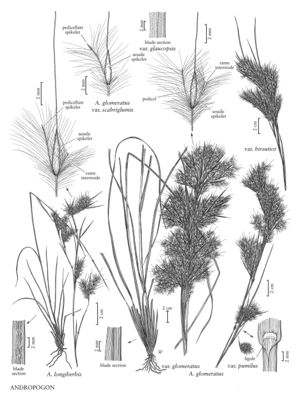Difference between revisions of "Andropogon glomeratus var. pumilus"
FNA>Volume Importer |
imported>Volume Importer |
||
| (3 intermediate revisions by 2 users not shown) | |||
| Line 46: | Line 46: | ||
|publication year= | |publication year= | ||
|special status= | |special status= | ||
| − | |source xml=https:// | + | |source xml=https://bitbucket.org/aafc-mbb/fna-data-curation/src/200273ad09963decb8fc72550212de541d86569d/coarse_grained_fna_xml/V25/V25_1598.xml |
|subfamily=Poaceae subfam. Panicoideae | |subfamily=Poaceae subfam. Panicoideae | ||
|tribe=Poaceae tribe Andropogoneae | |tribe=Poaceae tribe Andropogoneae | ||
Latest revision as of 17:57, 11 May 2021
Plants oblanceolate to obpyramidal in the upper portion. Culms to 2.5 m, but as short as 20 cm in poor soils; internodes not glaucous. Leaf sheaths usually smooth; ligules ciliate, cilia 0.2-0.9 mm; blades green, smooth or pubescent. Subtending sheaths of inflorescence units (2)2.9-4.3(5.2) cm long, 1.5-3 mm wide; peduncles (2)8-15(40) mm; rames 1.3-3 cm, exerted. Keels of lower glumes usually smooth below midlength, scabrous distally; anthers often retained within the spikelets.
Distribution
Va., Okla., Tex., Ark., Ariz., Calif., Ga., La., Miss., N.C., N.Mex., Nev., Puerto Rico, S.C., Virgin Islands, Ala., Utah, Fla.
Discussion
Andropogon glomeratus var. pumilus is weedy and grows in disturbed, wet or moist sites. It is abundant and widespread, extending from the southern United States through Central America to northern South America.
Selected References
None.
